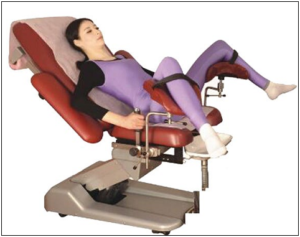What is a D and C surgical procedure?
A dilation and curettage procedure, also called a D&C, is a surgical procedure of the female reproductive organs.
During a D&C, the cervix (lower, narrow part of the uterus) is dilated (expanded). After dilating your cervix, your doctor uses a spoon-shaped object called a curette to remove tissue from the inner lining (endometium) of your uterus. It is done to to diagnose and treat certain uterine conditions — such as heavy bleeding — or to clear the uterine lining after a miscarriage or abortion
Who can perform dilation and curettage?
A gynecologist or obstetrician performs this surgery in their office or more commonly, a surgery center. It’s usually an outpatient procedure, so you go home the same day.
Where is it performed?
A D&C can be performed in an operating room in a hospital, in an outpatient clinic, or in an outpatient surgery center. Your blood pressure, pulse, and blood oxygen levels are monitored during the procedure.
How long does a dilation and curettage procedure take ?
The procedure itself typically takes only 15 to 30 minutes to complete. But if you are sedated, it can take longer for you to recover completely from sedation for you to be able to go home.
What is the difference between D&E (Dilation and Evacuation) and D&C (Dilation and Curettage)? Is a D&C done for abortion?
A D&E is done during a pregnancy to remove the pregnancy tissue – usually after a miscarriage or incomplete abortion. It uses a a vacuum aspiration, and requires more surgical instruments to remove the tissue (like forceps) A D&C is done on a non-pregnant uterus to remove the endometrium ( inner uterine lining). It takes less time and is simpler than a D&E.
Very often however, the two terms are used interchangeably. The term D and c may also be used for D and E.
What signs indicate that you need a D and C? What are the indications for a D and C?
Some indications or signs for a D and C are:
- To diagnose the cause of heavy menstrual bleeding.
- To identify the reason for bleeding between menstrual periods (intermenstrual bleeding).
- Irregular bleeding , especially in older women.
- Postmenopausal bleeding.
- To diagnose changes in the endometrium like endometrial hyperplasia (precancerous thickening of the uterine wall) and Uterine cancer.
- To clean out the uterus while removing a uterine polyp or small submucius fibroid.
- To check the endometrium in treatment of Infertility
What are the indications for a D and E ( Dilation and Evacuation)?
- To clean out the uterus after a abortion or miscarriage.
- To remove a molar pregnancy, a type of abnormal pregnancy.
- During a surgical abortion.
- As a follow up to a medical abortion.
- To clear out remaining placenta after delivery, to reduce excessive bleeding.
Does a D&C require anesthesia?
Most D&Cs are done under very short acting general anesthesia. The action of this type of anesthesia is very short can be quickly reversed, with the patient going home later the same day.
Is a Dilation and Curettage a minor surgery?
Yes, a D & C is considered a minor surgery that can also be carried out as a office procedure.
How can I prepare for a D&C?
Your doctor will give you instructions about the things you need to do and what to avoid. Some common advice about how to prepare for a D&C are :
- Get all the tests as advised by your doctor done before the surgery.
- Wear clean easily removable clothes since you will need to remove them to wear clothes provided by the center.
- Do not go when you are on your periods.
- If you are going to be sedated, do not eat or drink anything for at least 5 hours before the procedure.
- Do not douche.
- Carry a list of the medicines you are on, including any birth control medicine.
- Arrange for someone to be with you and to drive you home after the surgery.
What happens during the procedure?
Steps of a D and C:
- You will be anesthstised or sedated. Sometimes, only local anethesia may be injected into the cervix.
- You will be asked to lie down on the table.
- Your heels will rest on supports called stirrups. It is the same position while having a Pap smear.
- Your heartbeat, breathing, and breathing will all be monitored while you are strapped to devices.
- A speculum, a tool used to widen the vagina so that the cervix may be seen, is inserted by the doctor.
- The cervix is then properly dilated by inserting a series of larger rods called dilators until it is suitably opened.
- After that, the doctor scrapes the uterine wall within the uterus using a curette, a spoon-shaped tool.
- Once enough tissue is obtained, all the instruments are removed, and the tissue is sent for analysis.

What happens after D&C is done ?
After a D&C, you will need someone to take you home. If you had general anesthesia, you may feel groggy for a while and have some brief nausea and vomiting.
There may be mild bleeding and cramping. Your doctor will give you medicines for these symptoms.
Walk around and remain active after you recover from the sedation and are no longer groggy – this will help prevent formation of blood clots in your legs.
Avoid sexual intercourse for at least 2 weeks.
You can return to regular activities within one or two days.
How much bed rest is required after D&C?
After you have a D&C you should rest when you get home. You can go back to normal activities after 1 to 2 days (although the effects of the anaesthetic may make you feel tired). It is normal to experience some cramping or mild abdominal discomfort after a D&C.
How Long Will the Bleeding Last ?
Mild to moderate bleeding upto two weeks after the D&C procedure is quite normal. The main reason for bleeding is damage or injury to the uterine endometrium by the curette. The endometrium takes time to heal and bleeds until it is completely healed. There may also be some amount of injury to the cervix where is it held by instruments.
The average recovery period is 2 to 3 days. Some women who have extended pain and discomfort may take a week to recover from D& C.
Can you walk after a D&C?
Yes, you should be able to walk as soon as the general anesthesia wears off. This is within a few hours of the procedure. In general, it should be safe to get back to your regular daily activities about two days after undergoing D&C.
What are the complications of a D&C? Can a D&C damage the womb?
Complications are very uncommon after a D and C since it is a minor surgery. However, there are some potential complications:
- Heavy bleeding
- Infection
- Formation of blood clots in the legs.
- Uterine or bowel puncture.
- Asherman’s syndrome – The procedure has also been associated with a rare condition called Asherman’s syndrome in which bands of scar tissue (adhesions) form in the uterine cavity.
- Cervical incompetency – the cervical sphincter may become weak.
What are the signs of infection after a D&C?
Some symptoms that can indicate an infection are:
- Chills.
- Fever over 100.4 degrees.
- Foul-smelling vaginal discharge.
- Pelvic pain.
- Prolonged bleeding and cramping (longer than about two weeks).
- Tenderness in the uterus.
- Unusual drowsiness.
Does a D&C require stitches?
No, a D&C does not require stitches since tissue is not cut at any time
Do you need vaginal pads after D&C?
Yes, vaginal pads are needed since there may be some light bleeding for a few days after a D&C. Use sanitary pads until you stop bleeding. Using pads makes it easier to monitor your bleeding. Most women are able to return to work the day after the procedure.
Does a D&C require overnight stay in the hospital?
A D&C is usually done in a hospital without requiring an overnight stay. If sedation is used, the it may take about 4-5 hours for the sedation to decrease enough for you to be able to go home. Pain medicine is given before the procedure, so there will be minimal pain.
Can I take a shower or a bath after a D&C?
You can have a shower after a D&C but it is recommended that you do not take a bath. Do not swim or soak in a hot tub or bathtub for two to four weeks. This is to prevent anything from entering the vagina, which may cause an infection.
What to avoid after a D&C?
Please avoid:
- Vaginal intercourse for at least 2 weeks to allow the cervix to heal.
- Douching the vagina as it may cause infections.
- Use pads and avoid tampons. Tampons can cause infections and can also cause bleeding from raw areas in the cervix.
- Any vaginal medicines like pessaries.
Can you have kids after a D and C? Can fertility be affected?
In most cases, a D and C shouldn’t affect your ability to get pregnant in the future. Waiting for one to three natural menstrual cycles before trying to conceive will help the uterus to heal completely. But rarely, a condition called Asherman’s syndrome may develop. This syndrome causes formation of scars inside the uterus which may affect fertility.
What symptoms can you expect after a D&C?
After a D&C, you may have:
- Backache.
- Cramps similar to menstrual cramps.
- Expect to pass small clots of blood from your vagina for the first few days. You may have light vaginal bleeding for several weeks after the D&C.
Is a D&C a biopsy?
While an endometrial biopsy removes just a sample of tissue, a D&C removes much more of the top layer of the uterine lining. While the terms D&C and endometrial biopsy are used interchangeably, a D&C is a more extensive procedure than an endometrial biopsy.
Why do I get pain after D&C?
It’s completely normal to have cramping after D&C. The discomfort will initially be more severe before fading over time. Bleeding is generally light, and some people may only have spotting.
Can I climb stairs after D&C?
You can continue walking, stair climbing, and light housekeeping at your own leisure. After your procedure, you can drive again the following day.
What to eat after a D&C?
Please take a bland easily digestible diet in the first 6-12 hours after a D and C. After that you can take a normal diet.
The D and C procedure is a very routine, safe procedure done in clinical settings by a gynecologist with only minimal risk of complications. If your doctor suggests that you need a D and C, please discuss all issues and then go through with it. Surround yourself with support and be sure to give yourself plenty of time to heal.
Read More Questions and Answers on Pregnancy and Gynecology

I think I have a yeast infection
I think I have a yeast infection. I had vaginal itching earlier and it is itching again now. What should i do?

I think I have Bacterial Vaginosis
I think I have bacterial vaginosis. I have a vaginal discharge with a fishy odor since the last few days. When should I see a doctor?

I am in early pregnancy and have dark brown discharge
Early pregnancy bleeding. What is wrong with me? What should I do?

I am in Menopause and Bleeding Heavily
I am 52 years old and in menopause. I have been bleeding heavily for 8 days. What should I do now?

Missed birth control pill. Will I get pregnant?
I missed a birth control pill on the second week. Then I took the next one on time. I also took the placebo pills I day early. Will I get pregnant?

Why do I have Irregular Periods?
Why Are My Periods Irregular? I Stopped Taking Birth Control Pills 6 Months Ago? Is That The Reason?







